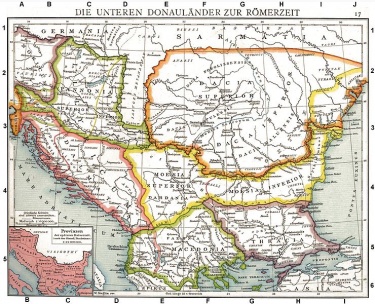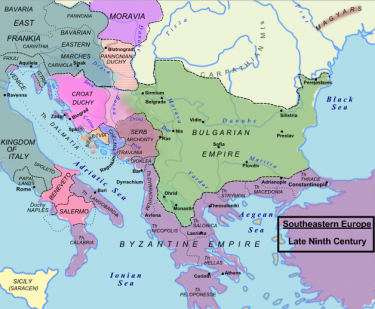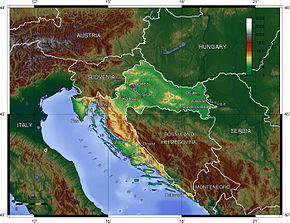Medieval Croatia
Medieval Croatia evolved from province of the old Roman Empire named Dalmatia. From 480 to 535 AD the former province of Roman Dalmatia was ruled by the Ostrogoths (a Germanic tribe related to the Goths). After the collapse of the Ostrogoth Kingdom it was divided between the Byzantine Empire and the Carolingian Empire - Franks (the old Roman neighbouring province of Pannonia was at one stage under the Avar, the Avar Khanate [1], later it became Lower Pannonia ruled by Slavs). Both the Byzantine Empire and the Carolingian Empire created their own Dalmatian Ducatus. The Dalmatian province had a Roman Latin-Illyrian population as well as Liburnians, Greeks, Guduscani[2] , Ostrogoths and the late arrivals, Slavs.
With time one of the Slavic tribes [3] within Dalmatian Ducatus of the Carolingian Empire became the political elite and the leaders (dux) of the province (i.e. Muisclavo modern: Mislav, Trepimerus/Trepimer modern: Trpimir I, etc.).
The fore-mentioned Slavic political elite from the late 9th century onwards were referred to as Cruatorum. This was the first time that the Croatian identity (Hrvat) was used c. 880 AD.[4][5] Cruatorum is a Latin translation of Hrvat. [6][7] In 879 the Croatian Duke Branimir received recognition from Pope John VIII as it became an independent state. The Dalmatian Ducatus was renamed Ducatus Croatiae. It had periods of vassalage under the Franks. Later it became a kingdom that was called the Regnum Chroatorum (Kingdom of Croatia 925–1102 AD, Croatian: Hrvatsko Kraljevstvo).
It had no permanent seat, Nin, Klis, Bijaci and Knin where some of the towns that have been mentioned. The Kingdom existed as a sovereign state for nearly two centuries.
Kingdom of Croatia
The new Kingdom of Croatia was ruled by Slavic nobility from the Dalmatian hinterland. The kingdom was named after the ruling class, which in turn ruled a medieval multi-ethnic state.
The Kingdom of Croatia with time became a powerful military state and expanded its borders. It had conflicts with the Hungarians (Magyars), Bulgarians and the Byzantine Empire (aka Eastern Roman Empire, please note they referred to themselves as 'Empire of the Romans' Latin: Imperium Romanum). As well as being a Christian state it then later became Catholic (the Slavs were pagans upon arrival in Roman Dalmatia). King Demetrius Zvonimir (1075-1089) took an oath of allegiance to Pope Gregory VII. It’s written language was Latin and Croatian Glagolitic. The Slavic rulers spoke old Slavic Chakavian.
The medieval state borders have been a matter of huge debate and will remain so until new historical evidence is found. However there is some factual information. Medieval Croatia incorporated Pannonia (also ruled by Slavs). The river Cetina was a major border in the south. The Roman cities of Jadera (Zara/Zadar), Spalatum (Spalato/Split), Ragusa (Dubrovnik) and Trau (Trogir) with their surrounding areas never became part of the state other than for a short period under Peter Kresimir IV. Other parts of the Dalmatian coast did. At time in the north the river Sava was a major border (Lower Pannonia). The region south of the river Cetina has been sometimes historically referred to as Red Croatia,[8] which would indicate Croatian influence/settlement was beyond the river Cetina. The Kingdom's borders were further expanded by Prince/King Tomislav and other rulers.
In the late 12 century the state fell into crisis when the neighbouring Hungarians (Magyars) used this opportunity to expand their own state. In 1102 it ceased to exist and it became politically part of the Kingdom of Hungary.[9] Parts of Croatian territory later came under Habsburg rule (Habsburg Monarchy was renamed Austro Hungarian Empire). The political power within the province was transferred from Dalmatia's northern hinterland to the city of Zagreb, further inland (Zagreb was a Roman town of Andautonia). Zagreb today is the capital of modern Croatia. Over time the coastal part of Dalmatia became part of the Republic of Venice. The Republic of Venice controlled most of Dalmatia from 1420 to 1797.
Within the old Roman province of Dalmatia's borders, history presents it self as a region of Europe that has a very rich, multicultural and multiethnic past. It could be mentioned the Croatia of old had a major influence on the region in terms of language. Croatian Slavic Chakavian became Lingua Franca of the area and started to replace Latin Dalmatian (Romance). This was more present inland at first than the Adriatic coast.
Notes and References
- ^ "Avar, one of a people of undetermined Euro-Asian origin and language, who played an important role in eastern Europe (6th–9th century)" referenced from: http://global.britannica.com/EBchecked/topic/45428/Avar The Slavs and Avar at one stage had a shared history.
- ^ self.gutenberg.org: "It has been assumed, that they were part of the Vandals, Goths or Lombards."
- ^ The term Slav was first used by the Byzantines-Eastern Roman Empire (i.e. Procopius-Byzantine scholar, Jordanes- 6th century Roman bureaucrat) and was recorded in the 6th century (cia. 550) in Greek (Σκλαβῖνοι-Sklabenoi). Later in Latin it was written Sclaveni.
- ^ Becoming Slav, Becoming Croat: New approaches in research of identities in post-Roman Illyricum by Danijel Dzino
- "The first evidence of the Croat name, dux/rex Croatorum, does not appear until the ninth century. The Charter of Duke Trpimir is indeed the oldest text that mentions the Croat name, dux Chroatorum but its authenticity is disputed for good reason. The earliest certain evidence is the title dux Cruatorum from duke Branimir's inscription (c. 880), so that before this date we cannot assume with certainty that the Croat identity existed at all."
- ^ A History of the Croatian Language: by Milan Mogus (p.13)
- ^ It is believed that Hrvat in medieval times was pronounced "Harvat or Hrovat". Hrovat was translated to Latin: Chroatorum and then simplified to Croatorum.
- ^ Hrvat or Horoúathos are names of Sarmatian origins. In 1853 a Russian archaeologist Pavel Mikhailovich Leontjev discovered the Tanais Tablets. The Tanais Tablets mention three men: Horoúathos, Horoáthos, and Horóathos (Χορούαθ[ος], Χοροάθος, Χορόαθος). They are written in Greek and are from the 3rd century AD from the city of Tanais, today's Azov, Russia. At that time the region had a mixed Greek-Sarmatian population (Persian in origins). Editors note: From the information above one can conclude that we are dealing with contact between Slavic and Sarmatian tribes from the late antiquity. From a modern day perspective the Sarmatian historical footprint is non existent. All traces of these people have disappeared other than Slavic terms surrounding the word or name Hrvat which translates to English as Croat.
- ^ When Ethnicity Did not Matter in the Balkans: by John Van Antwerp Fine. (p62-p63)
John V. A. Fine Jr:
- ^ Note: It has been mentioned that the Croatian province at first enjoyed a fair amount of independence under the Hungarians.
See also
External links
- Becoming Slav, Becoming Croat (East Central and Eastern Europe in the Middle Ages, 450-1450) by Dr Danijel Dzino
- Government of the Republic Croatia - Official Web Portal



